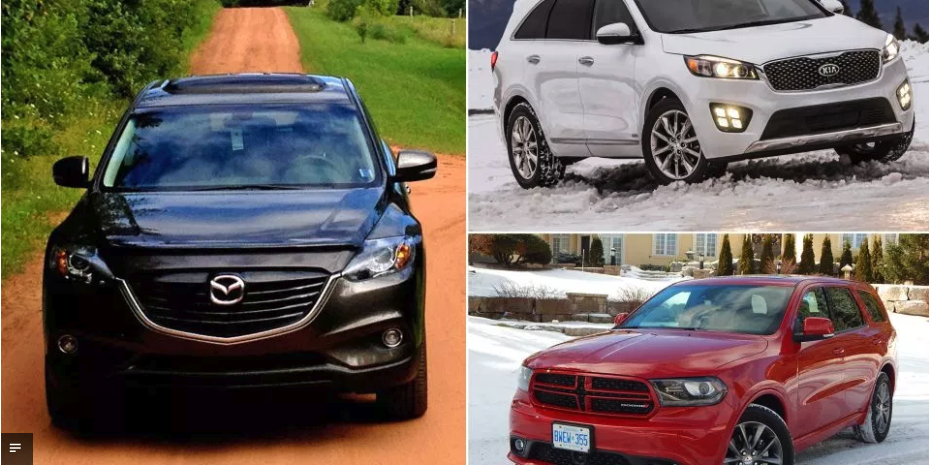Dear John: I’m looking for a luxury SUV on a budget

Story by John LeBlanc
Back in the old days — I’m talking around 1999 — if you were looking for a combination of a luxury sedan and the utility of an SUV, your choice was limited to high-end brands like Range Rover, BMW or Mercedes-Benz. With the past decade’s democratization of luxury, though, Canadians can now get many of the latest luxury SUV convenience features, infotainment technologies, performance and safety gear in less expensive mainstream models. And this month’s Dear John letter writer, David Truscott, a self-employed chartered accountant from Calgary, is looking for just such a vehicle.
Currently ready to trade in his 2011 Lincoln MKX midsize luxury crossover, David is looking for more room and more seating than the five passengers the Lincoln can carry. And in his quest to replace his Lincoln, it hasn’t helped that David’s brother drives a BMW X5, a luxury SUV he admires for its sophisticated ride and handling characteristics; however, being the “frugal accountant” that he is, David’s only given himself a monthly new vehicle budget that works out to a $55,000 purchase price — tens of thousands less than well-equipped luxury SUVs like the Bimmer.
David also wrote that fuel economy was not a priority. He is single, works from home, has no children to ferry around and does most of his 18,000 kilometres per year driving to and from his family cottage on Kootenay Lake, B.C., which he escapes to three to four times a year. As well, he recently bought a new boat and is looking for his next SUV to be able to tow the watercraft confidently over his Rocky Mountain cottage route. Plus when not towing, he’d like to enjoy a vehicle that can easily keep up with highway traffic.
David’s been happy with his existing Ford/Lincoln dealer where he is leasing his MKX. Out of loyalty, he’s already test-driven the three-row midsize SUVs they had in stock: the Ford Flex, Lincoln MKT and Ford Explorer. Unfortunately, David found that “they drove more like full-size trucks,” while one of his biggest disappointments was the lack of a V8, which ultimately led him to pen his note to yours truly.
Luckily for David, the popularity of high-end luxury SUVs has meant that mainstream brands now offer vehicles that offer similar levels of room, luxury kit and driving characteristics but for tens of thousands less.
For example, let’s start with the 2016 Dodge Durango R/T AWD.
Back in 2012, the Durango returned as a proper, 21st-century, midsize crossover, riding on a more space-efficient unibody platform it shares with the Mercedes-Benz GLE and GLS-Classes, as well as the two-row Jeep Grand Cherokee.
As such, with its well-controlled ride, taut handling and accurate steering, the three-row Dodge (especially in sportier R/T form) drives surprisingly more like it comes from Munich than Michigan. And like the Jeep, the Durango offers a class-exclusive V8 — in the $51,895 (base MSRP) R/T’s case, a 360-horsepower 5.7-litre unit, affectionately known as a “Hemi.”
Like the Durango, my second recommendation, the 2016 Kia Sorento has evolved from a truck-based to car-based platform. And while formerly sized like a compact, the latest generation Sorento has graduated to the midsize class.
To go from five to seven seats in the Kia, you’ll need to move up to the $35,744 Sorento LX, which comes with traction at all four wheels and a 290-horsepower, 3.3-litre V6 as standard fare. However, with David’s budget in mind, I can readily recommend going for the top-of-the-line $46,695 Sorento SX+, which adds features like Nappa leather seating, 360-degree cameras, adaptive cruise control and rear heated seats normally associated with those much pricier luxury SUVs.
Finally, my third recommendation for a sports luxury SUV-on-a-budget is the $45,995 2016 Mazda CX-9 GT. While an all-new CX-9 is coming next year, the current original still sits near the top of its class as a sporty and luxurious SUV for the masses.
In spite of the three-row crossover’s Ford-sourced 3.7-litre V6 making only 273 horsepower, the Mazda’s six-speed automatic transmission is very responsive. The CX-9 also corners relatively flat, aided by a steering system that is accurate, definitive and linear. The Mazda’s ride is well controlled too, and is rattle-free and hushed inside.
As much as all three of my recommendations would make great low-cost substitutes for much pricier luxury SUVs, based on David’s wish list, I have to show the Mazda out the door first.
As much as it sports the lowest sticker price here, with only a 1,588-kilogram limit, the CX-9 GT’s weak powertrain offers the least amount of towing capacity as well as the slowest zero-to-100 km/h time (7.8 seconds).
Next to go is the Kia.
Like the CX-9, compared to the Dodge’s huskier V8, the Sorento’s V6 limits its towing capacity (2,267 kg) and straight-line performance (0-100 km/h takes 7.4 seconds). Plus, with only 320 litres of cargo room behind its third-row seating, the Kia can’t match the Dodge and Mazda’s 487-litre rating.
Which leaves you, David, with the 2016 Dodge Durango R/T AWD. Able to tow up to 3,266 kg and sporting a 6.6-second 0-100 km/h time, the Dodge’s Hemi simply outclasses its V6 rivals.
Yes, the top-of-the-line Durango will max out your monthly car allowance, but I’m counting on the accountant in you to see the Dodge as the best pick for your luxury-three-row-SUV-on-a-budget wishes.





![[del.icio.us]](https://www.straight-six.com/wp-content/plugins/bookmarkify/delicious.png)
![[Digg]](https://www.straight-six.com/wp-content/plugins/bookmarkify/digg.png)
![[Facebook]](https://www.straight-six.com/wp-content/plugins/bookmarkify/facebook.png)
![[Google]](https://www.straight-six.com/wp-content/plugins/bookmarkify/google.png)
![[Reddit]](https://www.straight-six.com/wp-content/plugins/bookmarkify/reddit.png)
![[StumbleUpon]](https://www.straight-six.com/wp-content/plugins/bookmarkify/stumbleupon.png)
![[Twitter]](https://www.straight-six.com/wp-content/plugins/bookmarkify/twitter.png)
![[Email]](https://www.straight-six.com/wp-content/plugins/bookmarkify/email.png)